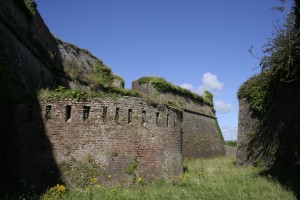
Work is now underway of developing a Conservation Plan for Duncannon Fort
A MAJOR conservation plan relating to Duncannon Fort is currently underway.
The work is being carried out by Stafford McLoughlin Archaeology on behalf of Wexford County Council.
The Fort is a national monument and is part owned by the OPW and the local authority. It was closed earlier this year on Health and Safety grounds resulting in the closure of some businesses and the relocation of others – including the Cockleshell Arts Centre.
The aim of the current work being undertaken at the site is to compile a comprehensive Conservation Plan which will be used to formulate policies aimed at enhancing the amenity as one of Wexford’s most important heritage sites.
The Echo spoke to Archaeologist, Catherine McLoughin, about the project.
She said the information gathered during the work will be collated with regard to various areas of interest relating to the Fort including its historical and archaeological significance.
“An ecology survey will be carried out of the flora and fauna of the fort and its existing buildings will be examined for bats,” said Ms. McLoughlin.
That work is being carried out by Ecofact Surveys.
A survey of the condition of the buildings will be undertaken by Ivor McElveen Associates.
The historical significance of the fort cannot be overstated; during the 1798 Rebellion, under the command of Major General Fawcett, it was the only loyalist strongpoint in County Wexford and became a refuge for loyalists at that time.
It was damaged by fire at the outbreak of civil war in 1922 and remained derelict until World War II.
A lot of refurbishment and expansion work was carried out at that time and it was then that the remaining wall of the original castle on the site was demolished.
It was used by the FCA until the 1980s and was acquired by the local authority in the 1990s.
Ms. McLoughlin said that the original name of the promontory, ‘Dunmechanan’ (the fort of the son of Canan) indicates that the site may have been the location of a prehistoric promontory fort.
Executive Engineer with Wexford County Council, Abraham Dunne, said the local authority is delighted that the work is being done.
Commenting on the development he told the Echo the Council was successful in its application to the Heritage Council for funding.
“The Heritage Council had a budget allocation under the Community-based Heritage Grant scheme 2015 of approximately €500,000,” he said.
“They received 611 applications and due to the limited funding available only one third of these applications received funding,” he added.
“We are delighted to have been amongst those successful.”
The local authority received €4,000 from the Heritage Council for the preparation of the Conservation Plan.
Mr. Dunne went on to comment: “The Conservation Plan will help ensure the Fort is managed and maintained in a sustainable manner [and] if so its rich heritage can be enjoyed by future generations.”
The Fort has had its fair share of significant guests throughout its history including King James 11 following the Battle of the Boyne when he sailed from Duncannon to Kinsale and then on to France.
King William also stayed at the Fort in September 1690 when bad weather delayed his return to England.
